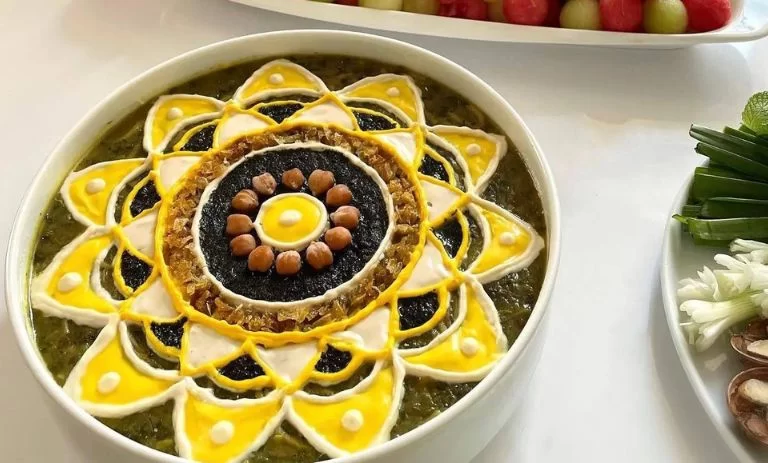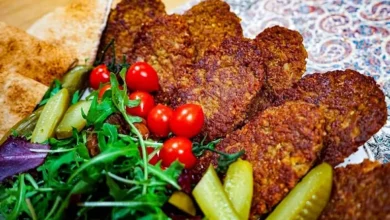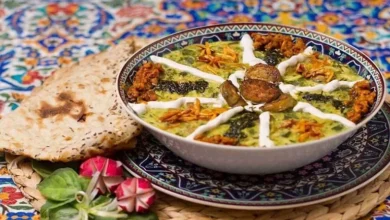Authentic Ash Reshteh recipe : Traditional Persian Ash
Ash Reshteh, a staple of Persian cuisine, is a comforting and flavorful noodle soup jampacked with legumes, herbs, and spices. This beloved dish is an integral part of Persian culinary tradition, often enjoyed during cold months but cherished year-round. Known for its rich history and nourishing ingredients, Traditional Persian Ash Reshteh is frequently prepared for religious offerings and gatherings. With our step-by-step guide, you’ll learn how to create an authentic version of this Iranian classic, perfect for sharing with family and friends.

Ingredients
Serves 4-6 people
| Ingredient | Amount |
|---|---|
| White beans | 1/2 cup |
| Pinto beans | 1/2 cup |
| Chickpeas | 1 cup |
| Lentils | 1 cup |
| Ash herbs | 500g |
| Garlic cloves | 8 |
| Large onions | 2 |
| Dried mint | 2 tablespoons |
| Reshteh noodles | 350g |
| Kashk (fermented whey) | To taste |
| Salt | To taste |
| Black pepper | To taste |
| Turmeric | To taste |
| Olive oil | Enough for frying |
Instructions
Step 1: Soak the Legumes – Start by soaking the white beans, pinto beans, and chickpeas in separate bowls filled with water for about 5-6 hours. Changing the water twice helps remove the beans’ natural gas-causing elements.
Step 2: Start Cooking Chickpeas – Rinse the soaked chickpeas and transfer them to a pot filled with 4-5 cups of water. Cook over medium heat until the chickpeas are tender yet maintain their shape.
Step 3: Prepare Beans – In a different pot, combine the white and pinto beans with 5 cups of water. Bring to a boil, then lower to a simmer until the beans are tender but not mushy.

Step 4: Ready the Lentils – Pour lentils into a bowl, cover with water, and let them soak for 30 minutes. Drain and set aside.
Step 5: Prepare the Herbs – Clean and wash the ash herbs thoroughly. Spread them on a clean cloth to dry. Once dry, chop them roughly to preserve their texture in the Ash Reshteh.
Step 6: Prepare Fried Garnish – Chop onions into small dice, and fry them in olive oil over low heat until golden brown. Remove them and use the same pan to lightly fry the garlic until aromatic.
Step 7: Fry the Mint – Add more oil if needed, and gently fry the dried mint until it changes color slightly. Be careful not to burn the mint.
Step 8: Begin Cooking Lentils and Herbs – In a large pot, boil water and add the soaked lentils. Once boiling, introduce previously cooked beans and chickpeas. After boiling, add the chopped herbs and season with salt.

Step 9: Add Flavorings – Introduce the half portion of prepared fried onions, garlic, and mint. Season with additional salt, black pepper, and turmeric. Let this simmer uncovered for about 30-45 minutes.
Step 10: Add Reshteh Noodles – Break the reshteh noodles in half and add them to the pot, cooking for another 15-20 minutes. Taste for seasoning, and add more salt if needed.
Step 11: Finish Up – If you prefer a split version with vinegar or kashk (fermented whey), divide the Ash Reshteh. Pour kashk over one half for a rich finish, while you can add vinegar to the other half for a tangy balance. Serve hot, garnished with the remaining fried onions, garlic, mint, and kashk.
Pro Tips
To prevent mushiness, make sure the pot is large enough so that the Ash Reshteh has plenty of space to simmer. Adjust the amount of noodles based on soup thickness preference. Fried onions, garlic, and mint form essential toppings and should be prepared with care to prevent burning. Constantly check if the water level is adequate; add boiling water whenever necessary to maintain the soup consistency without affecting the flavor adversely.
Frequently Asked Questions
Ash Reshteh’s key ingredients include a variety of beans such as chickpeas, lentils, and pinto beans, alongside reshteh noodles, onions, garlic, and aromatic herbs with toppings of fried garlic, onion, mint, and kashk.
Soaking beans overnight or for at least 5-6 hours in water significantly reduces cooking time, allowing them to soften faster during preparation.
Absolutely, Ash Reshteh is traditionally a vegetarian dish as it mainly relies on beans, herbs, and reshteh noodles. The rich flavors develop from the spices and garnishing rather than any meat products.




